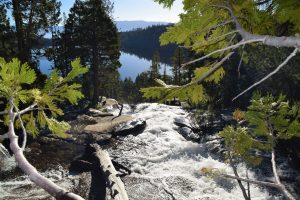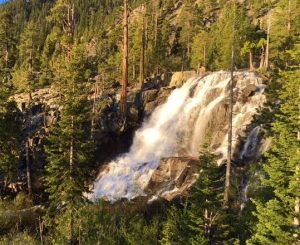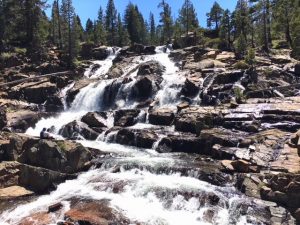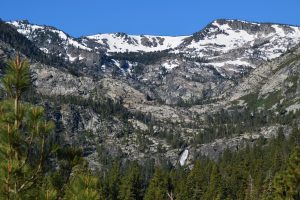
Atop Cascade Falls
Lake Tahoe Waterfalls
Lake Tahoe waterfalls attract thousands of nature lovers every year. While the waterfall flows are continuous throughout most of the summer months, it is during the snow-melt of spring and early summer (May and June) that is a particularly popular time. On any given day, you can see visitors enjoying Lake Tahoe waterfalls cascading over rocky ledges. They sit and observe, take photos, relax and as one group leaves another quickly replaces them.
5 Attributes That Attract Us
What is it about Lake Tahoe waterfalls, and waterfalls in general, that attracts us towards them? I contemplate this question by recalling my own personal experiences, and drawing on my beliefs and understandings. The outcome from this self-reflection are five attributes that I believe attract us. These attributes are scientific, emotional, creative, spiritual and ecological. I would like to share these with you in hopes they may refresh your own waterfall memories or evoke a curiosity to visit and have your own Lake Tahoe waterfall experience.
Scientific
Cascading waterfalls, crashing surf, flowing water, air after a thunderstorm, mountains and forests are all rich areas for negative ions. Negative ions are oxygen molecules that have gained or lost an electrical charge. Crashing and flowing water can disrupt the molecules and release the negative ions into the air. Negatively charged oxygen ions are beneficial to the human body. They can “increase the flow of oxygen to the brain; resulting in higher alertness, decreased drowsiness, and more mental energy,” says Pierce J. Howard, PhD, author of The Owner’s Manual for the Brain: Everyday Applications from Mind Brain Research and director of research at the Center for Applied Cognitive Sciences in Charlotte, N.C.. “They also may protect against germs in the air, resulting in decreased irritation due to inhaling various particles that make you sneeze, cough, or have a throat irritation.”
Emotional
When observing a waterfall, walking along the beach or being in nature, do you notice a feeling of calm and euphoria? If so, you are likely feeling the effects from negative ions. These oxygen rich ions stimulate the production of a natural mood stabilizer serotonin – helping regulate anxiety, depression and happiness. We feel good.
Spiritual
A Lake Tahoe waterfall, with its dynamism of hurtling water, thunderous sounds, and natural surroundings, can create a sense of wonder and connection to something bigger than we are. You may experience, as I do, an open-heartedness and gratitude for the life we are given, and the life’s abundance around us.
Early indigenous people sought the source of life-supporting fresh water. Living in the low lands, among the abundance of edible plants and animals, “natives” gazed toward the high mountains as the heavenly source of life giving water. They believed it was in these high places where the gods must be living and giving life through water. In their curiosity, they traveled upstream seeking the source of life. When they arrived at cascading waterfalls and flowing waters, they settled in reverence and gratitude for the Great Spirit’s abundance.
Creative
Enhanced mood, a feeling of connection, being moved and awestruck with the surrounding natural beauty of a Lake Tahoe waterfall, may inspire our desire to be creatively expressive. We may write songs, poetry, take photos or paint scenes to capture the moment that can be with us long after we leave the scene. In fact, one Lake Tahoe waterfall, Eagle Falls, cascades into Emerald Bay, in South Lake Tahoe, which is one of the most photographed places in the U.S.
Ecological
To view Lake Tahoe waterfalls is to witness ecology in action – a life cycle. A cycle in which water evaporates from ocean sources forming clouds. During winter months, these clouds yield snowfall that are stored for months on the high Sierra Nevada peaks as water banks. During the warmth of spring and summer, these water banks pay dividends by releasing crystalline fresh waters. These waters are essential life-supporting sources for agriculture, wildlife and utilitarian purposes. Much of the water eventually flows back to its source – the world’s oceans. Then the cycle repeats itself.
Now, you can enjoy your own Lake Tahoe waterfall experiences by visiting one or all of the following Lake Tahoe waterfalls.

Eagle Waterfall
Eagle Falls. Eagle Falls is one of the most visited and photographed Lake Tahoe waterfalls. You can drive or ride your bike to one of the country’s most beautiful settings, Emerald Bay State Park, site of the waterfall. To get there travel west from South Lake Tahoe, turn right at the “Y” junction and head north on Highway 89, Emerald Bay Road. You will travel on a two-lane road high above two bodies of water, Cascade Lake on the left, where you be able to see Cascade Falls, and on the right Emerald Bay of Lake Tahoe. This section of roadway is actually on a glacial moraine – a geologic feature formed from glacial movement. Once you descend passed Inspiration Point, you will notice a parking area on the left – park there. Cautiously walk across the highway to view the Falls.

Glen Alpine Waterfall
Glen Alpine Falls. Glen Alpine Falls is the second most popular Lake Tahoe waterfall because it too is accessible by driving or riding your bike. This is a beautiful waterfall. It cascades down large blocks of rock and is an ideal site for creativity or enjoying a picnic with family and friends. Again, traveling from South Lake Tahoe, head west and turn right on Hwy 89 and pass Camp Richardson Resort. Approximately 1/2 mile, turn left on Fallen Leaf Road. Cautious and courteous driving is needed along this 5 mile stretch because it is a narrow road most of the way. Pass the Fallen Leaf Resort & Marina, and turn left at the fork in the road and pass the fire station. Drive slowly up this single lane road with a very irregular surface and be cautious with hikers and other vehicles on the road. You will see the falls and park where you can – there are no designated paved parking spots here.

Cascade Waterfall
Cascade Falls. Cascade Falls is a local’s favorite because it is a bit out of the way – requiring you to hike. Like the previous described waterfalls, Cascade water comes from Desolation Wilderness snowfields and enters Cascade Lake. While not a strenuous hike, you should have moderate fitness and agility skills because 3/4 of the trail is mostly rocks. When you drive to or from Emerald Bay, you will see it – it is picturesque at the base of the high Sierras. Looking up above the falls, you will notice terrain features shaped from the glaciers cutting action moving down from Desolation Wilderness and forming Cascade Lake.
The trail head is at Bayview Campground. Please sign-in at the trail head as you are entering a designated federal Wilderness area. You can park here or across the highway at Inspiration Point. From South Lake Tahoe, travel along Highway 89, Emerald Bay Road, as if you were going to Emerald Bay. Be sure to take a lunch, relax and absorb the natural beauty of the waterfall as you overlook the lakes of Cascade and Tahoe.

Horsetail Waterfall
Horsetail Falls. Horsetail Falls is a further driving distance from South Lake Tahoe, about 30 minutes, but can be well worth it. Located just off Hwy 50 at Twin Bridges is the Pyramid Creek Trail. There is a designated parking area with a $5.00 day fee. Hike up this 3.1-mile trail being cautious of large, and at times, slippery rocks. As you gain elevation the hike can become moderate to difficult, and the trail can disappear. It may be best to go at your own speed and fitness level stopping anywhere along the trail and enjoying the clear fast moving stream and views. If you are fit and well equipped for a strenuous hike, you can climb to the top of the falls, which enters the Desolation Wilderness. To enter the Wilderness area be sure to sign the access permit.


